The Halfmoon Betta, a highly sought-after variety of Betta fish, is named for its distinctive fins that spread out to form a 180-degree fan. This betta breed is available in a wide range of colors and patterns. It features two primary tail types and requires a bit more care than other Betta fish.
Keep reading to learn all about the Halfmoon Betta behavior, appearance, habitat, and more to help you decide if they’re the right fit for your aquarium.
A Brief Overview Of Halfmoon Betta
| Common Names | Halfmoon Betta |
| Scientific Name | Betta splendens |
| Adult Size | 2.5 inches (6.35 cm) |
| Lifespan | 2-4 years |
| Family | Osphronemidae |
| Origin | Southeast Asia, Thailand, Cambodia |
| Temperament | Aggressive |
| Tank Mates | Snails, shrimp, peaceful small fish |
| Minimum Tank Size | 5 gallons |
| Diet | Carnivorous, requires high-protein diet |
| Care Level | Moderate |
| Breeding | Bubble nest builder, complex process |
| pH | 6.0 – 7.5 |
| Temperature | 78°F – 80°F (25.5°C – 26.5°C) |
Appearance Of Half Moon Betta

Colors: The Halfmoon Betta bursts with vibrant colors. This spectrum includes a range of captivating shades like shimmering blues, fiery reds, lush greens, vivid oranges, and regal purples. These colors are not only enchanting but are a testament to the fish’s health and environment.
Gender: When distinguishing between male and female Betta Halfmoon, their coloration can offer some clues. Males are typically more vibrant, displaying bolder and brighter shades, while females often have softer, more muted tones. This stark difference in color makes it relatively easy to differentiate between the two.
Special Varieties: Among the various shades, some stand out due to their rarity. White bettas are a less common, yet captivating sight. However, even rarer are albino bettas. These unique fish have a translucent quality to their scales and display notable pink or red eyes, making them a standout in any collection.
Tai Shape: One of the defining features of the Halfmoon Betta is its tail. It possesses a distinct semi-circular shape that closely resembles the form of a half-moon, hence its name. This tail is not just unique in shape but also in its graceful movement, adding to the fish’s overall allure.
Size: In terms of size, the Halfmoon Betta isn’t a giant. It reaches a manageable adult size of about 2 ½ inches, making it suitable for various aquarium sizes.
Halfmoon Bettas Typical Behavior

Male Halfmoon Bettas display territorial tendencies, particularly towards their male counterparts. While they typically prefer solitude, harmonious coexistence is possible with careful tank mate selection.
The condition of their fins speaks volumes. Flowing, relaxed fins indicate contentment, while stiff or tense fins can signal stress or potential aggression.
Their swimming patterns are windows into their emotional state. Smooth, calm movements reflect happiness, while erratic or collision-prone behavior may indicate stress.
These bettas possess an impressive ability to recognize their caregivers. They often associate human presence with feeding time, showcasing their cognitive awareness.
Halfmoon Betta Fish Variants and Color
Aquarists take creativity to new depths by marrying different color and tail types, giving rise to beautiful betta fish like the Koi Rosetail Halfmoon and the Dragonscale Dumbo Halfmoon.
1. Key Variants
Betta Halfmoon Plakat: Celebrated for vibrant hues and flowing fins, this variant boasts an appealing visual allure.

Dumbo Halfmoon: Its striking features include elongated dorsal and pectoral fins that capture attention.

Twintail Halfmoon Betta: Distinguishes itself with a split tail that unfurls into a stunning 180-degree arc when flared.
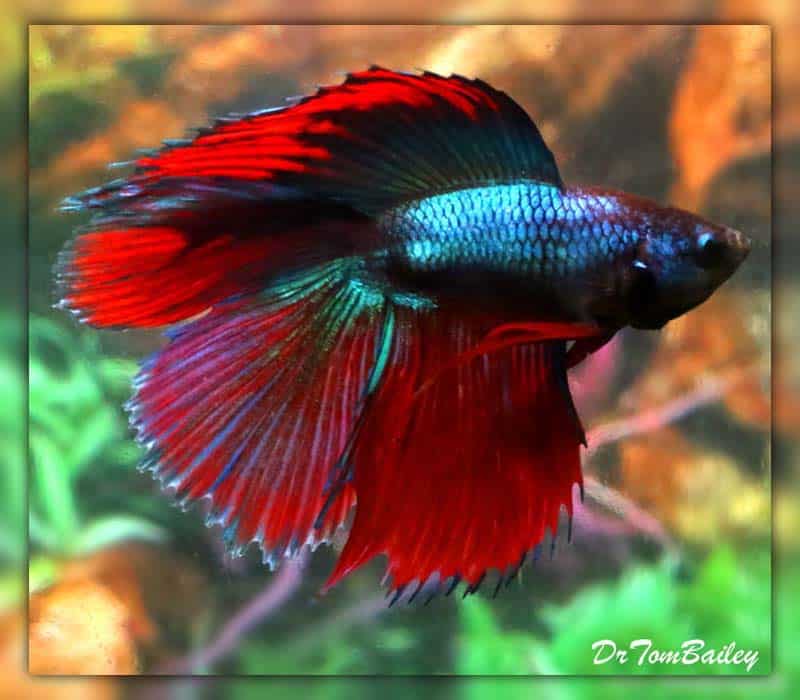
King Halfmoon: It features a larger body and sleeker fins, while retaining the signature 180-degree tail flare.

Rosetail Halfmoon: Born from selective breeding, this variant showcases an elaborate, rose-like tail fin.
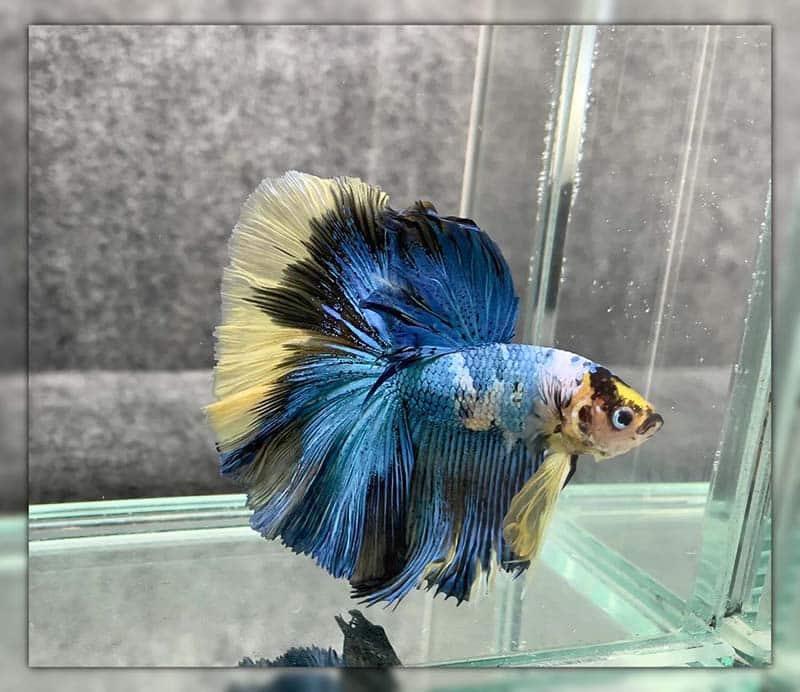
Over Halfmoon Betta Fish: Takes drama to new heights with a tail flare exceeding the classic 180-degree mark.
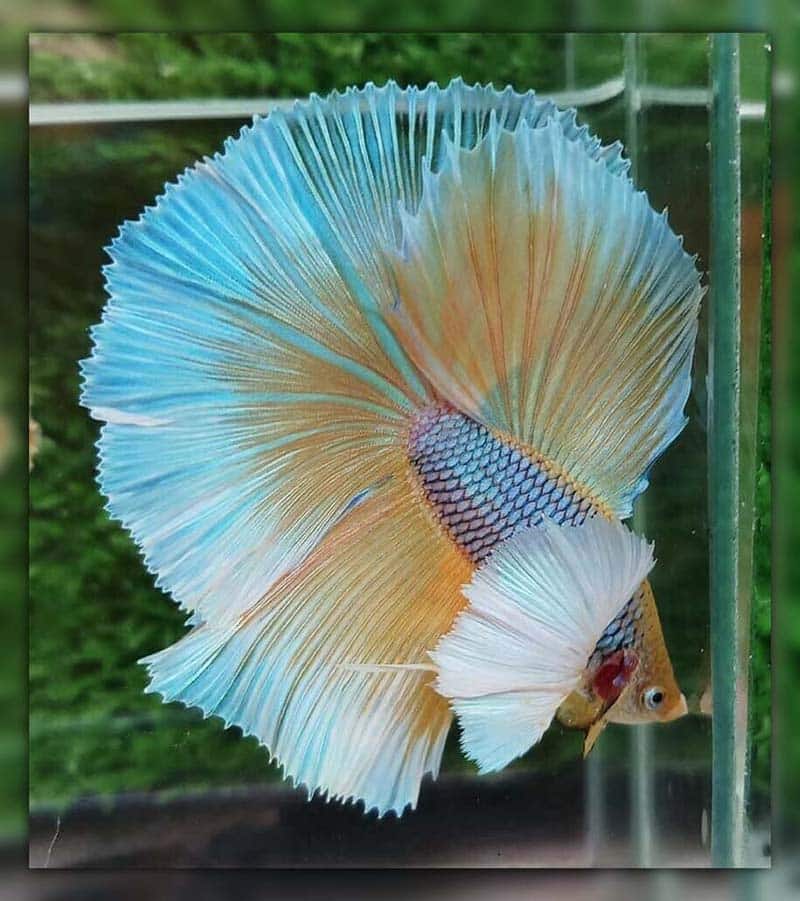
2. Color Types
One-Colored Halfmoon: Embracing a single vibrant hue that’s a testament to the beauty of simplicity.

Bi-Colored Halfmoon: Sporting a captivating duo of colors, it strikes a balance between vibrancy and contrast.
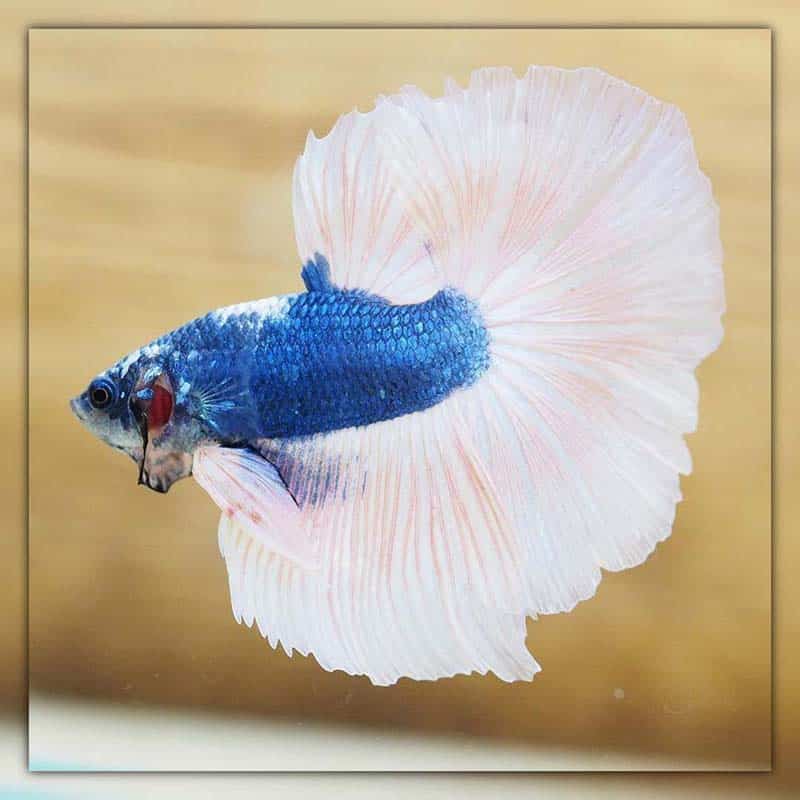
Dragon-Scale Halfmoon: Recent and popular, its scales mimic the allure of dragon armor, making it an instant eye-catcher.
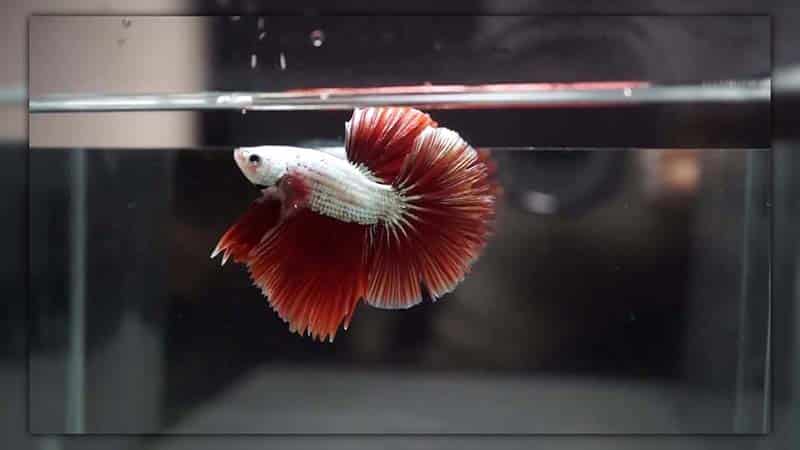
Marble Halfmoon: A mesmerizing dance of color-changing scales adorned with irregular patches.
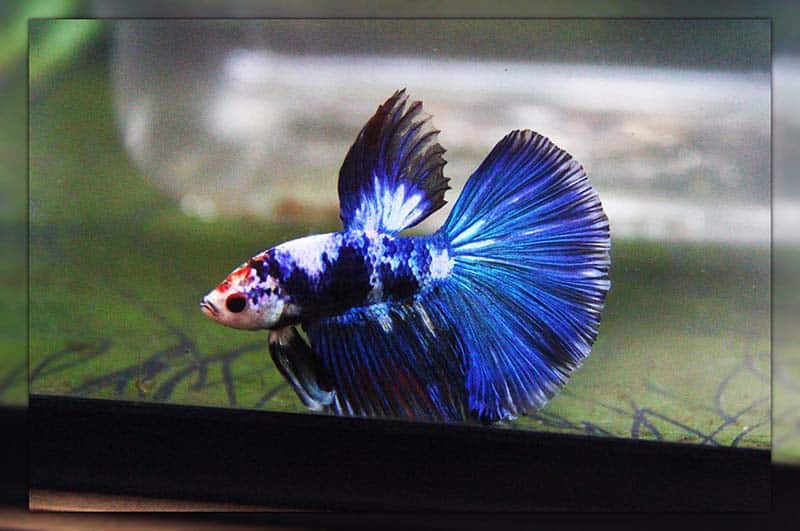
Galaxy Koi Halfmoon Betta: A harmonious blend of koi-inspired shades like orange, white, and black.
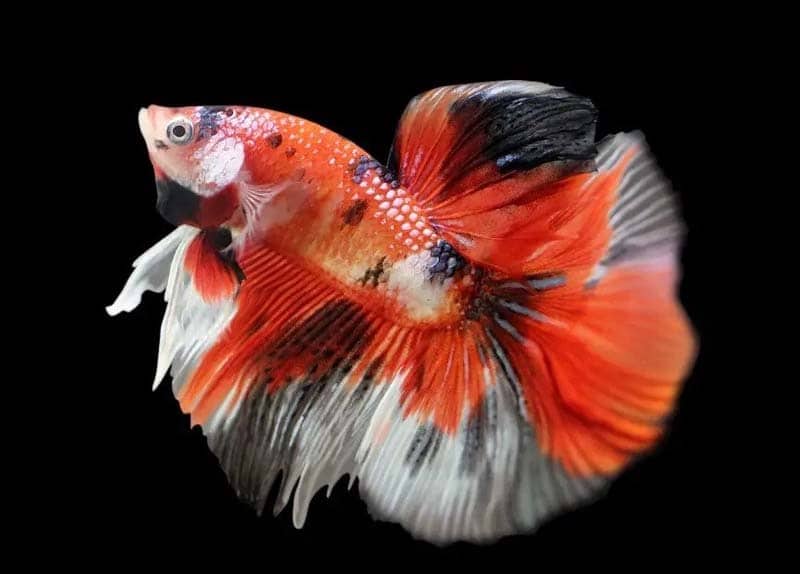
Mustard Gas Halfmoon: Rare and intriguing, it features the contrasting allure of mustard-yellow against a dominant dark hue.
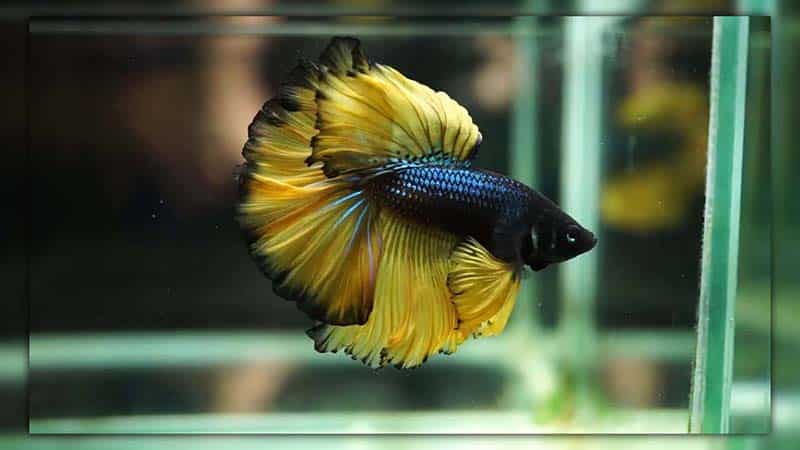
Butterfly Halfmoon: Elegantly two-toned fins mimic the grace of butterfly wings.
Halfmoon Betta Lifespan
On average, a Halfmoon betta can expect to enjoy a life of around 3 years. However, their potential for longevity extends with attentive care, as some individuals have demonstrated thriving for up to 5 years, showcasing the impact of proper care on their overall lifespan.
It’s crucial to recognize that the Halfmoon betta, like all its counterparts, possesses a delicate constitution. This fragility makes them susceptible to a range of diseases and health challenges that might impact the length of their life.
While the Halfmoon betta’s average lifespan might be relatively shorter, your active involvement can significantly enhance the quality of their years. The fully matured halfmoon betta typically reaches an average length of approximately three inches.
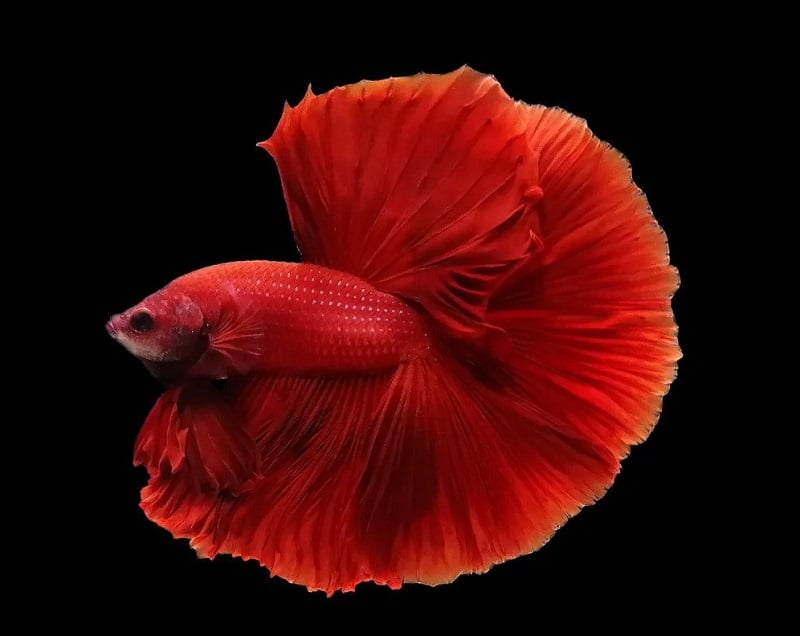
Male Halfmoon Betta vs Female Halfmoon Betta
- Aggression Levels: Tend to be more aggressive, especially towards other males in competitive and territorial environments.
- Physical Characteristics: Boast vibrant colors with long, flowing tails, giving them a captivating display.
- Aggression Levels: Generally more peaceful, capable of coexisting harmoniously with other fish species.
- Physical Characteristics: Display more subdued colors with fins that are less flamboyant compared to males.

These differences are essential to consider for maintaining harmony in the aquarium and for successful breeding.
Halfmoon Betta Fish Care: What To Feed

Halfmoon Bettas are inherently carnivorous. To meet their nutritional demands, provide betta food with protein-rich diet. This can include choices like bloodworms, dried shrimp, mosquito larvae, and live brine shrimp. Additionally, consider giving them a cooked and peeled green pea once a week; it’s beneficial for digestion.
While not directly related to feeding, the cleanliness of the tank has indirect effects on your Betta’s overall health. A well-maintained tank prevents harmful organisms and algae from flourishing, ensuring that your Betta’s environment remains conducive to its health.
It’s ideal to feed your Halfmoon Betta once daily. However, portion control is crucial. Be cautious not to overfeed, as it can lead to health complications. Always monitor the amount your Betta is consuming to keep its diet balanced.
Breeding the Halfmoon Betta
When looking to breed Halfmoon Bettas, several elements come into play. Each factor, from the fish’s age to their behavior, plays a role in ensuring the next generation thrives.
- Ideal Age for Breeding: Breeding Halfmoon Bettas within the age range of 4 months to 1 year generally yields the best results. During this period, the fish have reached sexual maturity, positioning them well for reproductive success.
- Separate Tank: The environment in which the bettas breed is pivotal. For optimal results, it’s advised to place the breeding pair in a separate tank, away from other species. This isolation offers them the seclusion necessary for their intricate courtship rituals without the interference of other fish.
- Size Differences and Visible Signs: Effective breeding often requires the male to be slightly larger than the female. As the time for mating draws near, the female exhibits various physical changes. She sports a darker hue and distinct stripes on her body. Furthermore, her ovipositor – a small white dot located between her fins – becomes more apparent. This dot is a clear indicator of her readiness to breed.
- Courtship Behavior: Halfmoon Bettas engage in a captivating courtship dance. The female showcases her interest by flaring her tail and executing enticing body movements, signaling to the male her willingness to mate.

Conclusion: Halfmoon Betta Suitable for Your Aquarium?
The Halfmoon Betta makes for a visually stunning addition to any freshwater aquarium, thanks to its vibrant colors and elaborate fin designs. They’re relatively easy to care for, but do pay attention to their specific needs, particularly regarding water quality and tank conditions.
If your tank offers enough space and doesn’t house any incompatible fish species, a Halfmoon Betta can thrive and become a captivating focal point in your aquatic setup. By adhering to the guidelines mentioned above, you’re well on your way to enjoying the beauty and unique characteristics of this remarkable fish.
National Park Aquarium hope you’ve gained valuable insights to make your aquarium a happy home for your vibrant and beautiful Halfmoon Betta.













